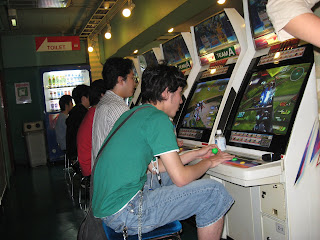The current emperor and empress only have a daughter, and when she was born, there was controversy over whether this daughter would be allowed to carry on the royal line. After much dispute between the conservative, traditional side with the new, liberal side, the government decided she will not be allowed to carry on the royal line; her male cousin will.
After the palace, we took the subway to Asukuza where we saw the famous Senso-ji temple. It was beautiful, and we were able to go up close to see the shrines. The story is that the temple was built because a statue of Kannon, the goddess of mercy, was fished out of the nearby river. This temple, finished in 645, is Tokyo's oldest Buddist temple. Then we had time to go around and shop for a bit. This area seemed to be filled with tourists because I heard more English today, outside of people on this trip, than I have in the last week and a half.
I had soy sauce ramen for lunch, yummy.
After lunch, we headed to Akihabara, which is the electronics district in Japan. This place has the highest concentration of televisions, cameras, digital cameras, etc that I have ever seen. We walked into one of the biggest stores and it had seven floors! Every floor was filled completely with different gadgets and toys. That, and also the advertisements, was almost visually overpowering. A definite highlight was seeing the world’s biggest TV, which costs around $50,000 USD. Afterward, we walked into the older part of Akihabara where there are stalls that specialize in selling particular electronics, such as lightbulbs, switches, and wires. It was really intense to see how Japan thrives off of electronics.
Equally intense was exploring the Sega store in Akihabara. It had five floors and is packed with arcade games, whose titles I don’t even know. What was really interesting to see was how many business people there seemed to be at the Sega store. There were teenagers and younger men there, but there was also a high number of businessmen, who seemed to be taking their lunch breaks by playing arcade style games.
We explored a big more of the district and wound up at this store called Super Potato, which is supposedly where old school games wind up. Inside the store were new, unopened games that were never sold in the United States. The guys found games that they’ve always dreamed about playing, and it was really interesting to see how game-centric the Japanese are. The gamer revolution really is all about Japan.
Note: I don’t remember seeing any women in the Sega store or Super Potato.
We took the JR Line to Harajuku and spent about an hour and a half there exploring the shops and people watching. I’ve always heard so much about Harajuku, mainly from Gwen Stefani, so I was excited to see crazy styles and outfits. Much to my disappointment, I did not get to see as many as I thought I would. There were definitely some standout outfits, but most of the people I saw in the district wore typically stylish and fobby Japanese outfits. A lot of the styles on some people and in the shops there are definitely unique and irreproducible., such as the girl I saw dressed in a pink Little Bo Peep outfit.
After a break, we went to Shibuya, which is known for being where the young people hang out. It was crazy to see all these lights and buildings when we came out of the subway station, and I felt like I was in New York City’s Time Square for a split second. There were so many neon signs and bright lights and so much hustle and bustle. Even though it was a Tuesday night, Shibuya was packed with people, and we got to see a slight Tokyo Drift-esque scene at the “scramble” (where everyone crosses the intersection), complete with fancy cars and high speeds.
I ate a curry soup with chicken and vegetables for dinner. Food is really expensive in Shibuya, I paid around 1140 yen for my dinner.
Then we just walked around, looking at all the people, cars, signs, and buildings. Even though I had seen many of these things before in Japan, it just seemed different in Shibuya because everything was packed together so densely. There are main streets but the alleyways are more of the specialty of Shibuya. There are alleyways for ramen, alleyways for anime, and alleyways for pachinko. It seemed like I could endlessly explore Shibuya and not get bored of what I was seeing or doing.








No comments:
Post a Comment